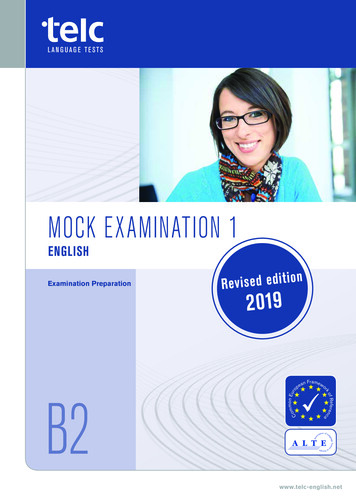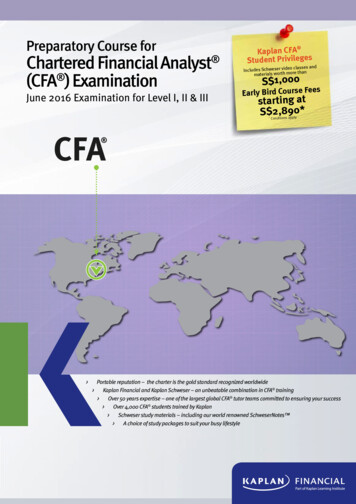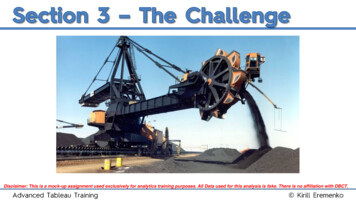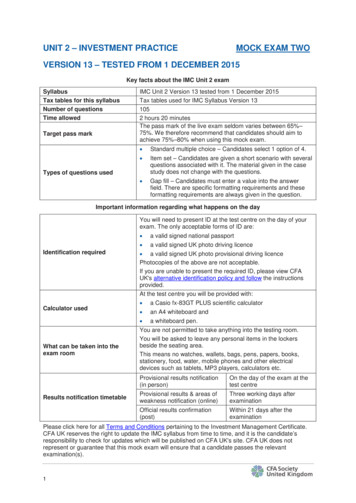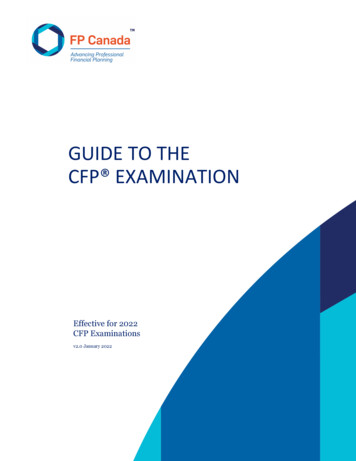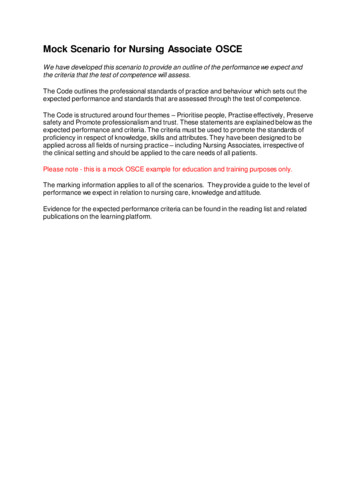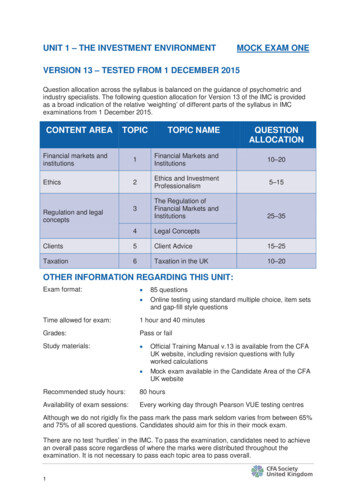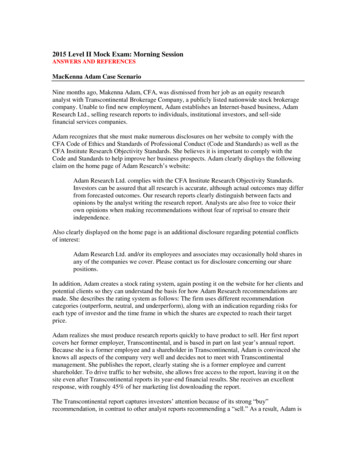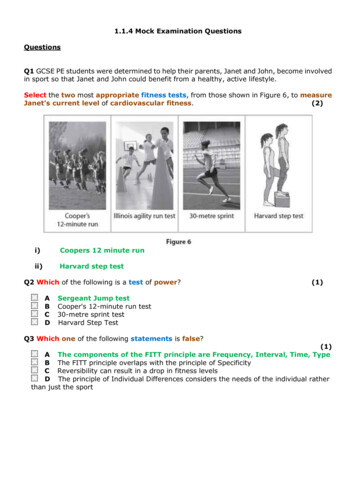
Transcription
1.1.4 Mock Examination QuestionsQuestionsQ1 GCSE PE students were determined to help their parents, Janet and John, become involvedin sport so that Janet and John could benefit from a healthy, active lifestyle.Select the two most appropriate fitness tests, from those shown in Figure 6, to measureJanet's current level of cardiovascular fitness.(2)i)Coopers 12 minute runii)Harvard step testQ2 Which of the following is a test of power?ABCD(1)Sergeant Jump testCooper's 12-minute run test30-metre sprint testHarvard Step TestQ3 Which one of the following statements is false?(1)A The components of the FITT principle are Frequency, Interval, Time, TypeB The FITT principle overlaps with the principle of SpecificityC Reversibility can result in a drop in fitness levelsD The principle of Individual Differences considers the needs of the individual ratherthan just the sport
Q4 Imran plays for the school football team. At the start of the season the team undergo aseries of fitness tests. In the table below:State the most relevant fitness test for a football player (not goalkeeper)(1)Explain why this fitness test is relevant to Imran.(1)Tick mostrelevant fitnesstest for footballplayerIllinois Agility RunExplanation why thisfitness test isrelevant to football player This fitness test is themost relevant becauseit tests the ability tochange direction withspeed and control whichis required by a footballerwhen dribbling betweendefendersHand grip strength testStanding Stork testQ5 As part of his Personal Exercise Programme (PEP) Joe measures his heart rate to check onhis fitness levels.(a) The heart rate monitors in Figure 5 show three different heart rate values. Re-orderthese heart rate values and plot a graph to show Joe's resting, working and recoveryheart rate.(2)The plots should be ordered as;70 for Resting heart rate120 for Working heart rate80 for Recovery heart rate(1 mark)Graph should also be a line graph (1 mark)
(b) Explain why you have plotted the values in this order(1)I have plotted these values in this order because resting heart rate (70 BPM) is thelowest value because it has the lowest demand for oxygen, working heart rate (120BPM) as the highest value because it has the highest demand for oxygen and recoveryrate (80 BPM) is in between value because oxygen is still required because of oxygendebt acquired during exercise(c) Explain why you have plotted the recovery heart rate(1)I have plotted recovery rate (80 BPM) as the in between value because oxygen is stillrequired because of oxygen debt acquired during exerciseQ6 Rob and Imran regularly participate in physical activity. Rob takes part in cross-countryruns on a regular basis. Imran plays for the school football team. Both activities require theboys to work aerobically and anaerobically. For each of the following statements, statewhether the activity is aerobic or anaerobic.(i)Rob kept a steady pace for the first mile and a half of the race.Aerobic(1)(ii)At one point near the end of the race Rob had to sprint to prevent the runnerbehind over taking him and going into the lead.(1)Anaerobic(iii)During the fifth minute of the game Imran had a chance to score a goal, he struckthe ball hard and gave his team an early lead.(1)Anaerobic(iv)In the second half of the game Imran spent a lot of time slowly jogging back intoposition.(1)Aerobic(v) Name a training method that Rob and Imran could both use for their activityFartlek or Circuit or Continuous or Interval(v)(1)Explain how each boy would adapt this training method to suit his own activity
(2)Training method that How training method wouldcan be used by both be adapted by Robboys(Cross-country runner)How training method wouldbe adapted by Imran(Footballer)FartlekBy training on different terrain(up and down hills)By using sprints of 10 to 50metres which is relevant infootballContinuousBy keeping at the same pacefor the distance of typicalraces to increasecardiovascular fitnessBy training continuously for 90minutes which is the length of thegameIntervalBy running up hills for onerepetitionBy using a range of sprintdistance from 5 metres to 40metres which is specific infootballBoth boys were encouraged by their teachers to set SMART targets to help them improvetheir performance in their activities.(i) Give two reasons why target setting could help improve performance.One reason it could help improve performance is it will motivate them.reason is that it will help them monitor progress(ii) Give an example of a measureable target for Rob.(2)A second(1)One example of a measureable target is to beat his personal best (PB) by 10 secondsQ7 GCSE PE students were determined to help their parents, Janet and John, become involvedin sport so that Janet and John could benefit from a healthy, active lifestyle.Janet needs to select a relevant method of training to improve her cardiovascular fitness. Fourdifferent methods of training are shown in Figure 7.
(i) Identify the most relevant and least relevant method of training to help Janetimprove her cardiovascular fitness from Figure 7.(2)Most relevantLeast relevantContinuous trainingWeight training using heavyweights(ii) Identify a sporting activity where the performers would use the training method youidentified as least relevant to Janet.(1)Shot putt(iii) Before returning to physical activity Janet and John should complete a PAR-Q. What is thepurpose of a PAR-Q?(1)The physical activity readiness questionnaire determines whether an individual is safeor ready to participate in physical activity
Q8 * Eshan is inspired by performers in the run up to the London 2012 Olympic and ParalympicGames, and is determined to improve his performance. He decides to set SMART targets asa first step to achieving his long-term goal.Discuss the use of target setting to improve performance. You must make reference toexamples in your answer.(6)Plan3.GOAL SETTING can achieve this by;1.Increasing FOCUS2.Increasing MOTIVATIONMENTALLY PREPARE athletes for the target4.Providing INDICATION of PROGRESSDescribe, explain and apply the principles of setting SMART targets SPECIFIC; this is when the goals are CLEAR and to the POINT (I want to jump 4 METRES in the longjump)MEASURABLE; this is to measure your RESULTS and IDENTIFY PROGRESS (I will measure my jumpseach week to see if I am IMPORVING)ACHIEVABLE; this is when the goals are CHALLENGING but REACHABLE (I jumped 3 METRES 90 CMSlast season so this difference is a challenge but I could do it)REALISTIC; this is MANAGEABLE to my LEVEL of ABILITY (I could jump 3 METRES 90 CMS in YEAR10 so this is within my ABILITY now that I am in Y11)TIME-BOUND; this is when you state a specific START DATE and a specific END DATE when you hope toachieve the goal (I will start my programme on 1st May and I want to reach my goal in 2 MONTHS – the30th June)One use of target setting to improve performance is setting specific goals. This issetting goals that are clear so the performer knows what they are trying to achieve. Anexample is in the 100m by trying to improve your start which is important to increase yourfocus and concentration whereas a non-specific goal would be too vague and lackclarity for the individual leading to limited improvement.A second use is setting measurable goals. This is so you can quantify or measure yourspecific goal. An example is in the 100m is reducing your time from 11 seconds to 10.9seconds which is important to clearly see when you have achieved it and it also increasesfocus and motivation whereas with a non-measurable goal you would be unaware if youhad achieved it.A third use is setting achievable goals. This is setting goals that are possible to attain orcomplete. An example is setting the completion of a marathon when the individualsuffers from chronic knee joint pain as this may not be achievable and lead to a lack ofmotivation whereas with an achievable goal the individual is motivated to achieve itA fourth use is setting realistic goals. This is setting goals that are challenging but nottoo hard. An example is a footballer setting the goal of scoring 12 goals in a season whenlast season they scored 10 whereas a footballer who sets 30 goals is being unrealisticwhich will lead to increased stress levels and demotivationA fifth use is setting time bound goals. This is setting goals that have clear start and enddates. An example is the same footballer who uses the start and end of the season toreference the progress that they have made whereas a footballer who doesn’t use theseasons will not have been able to measure the rate of progress which can lead to a lackof focus and concentration.Total Marks 30
Mark SchemeQ1.Q2.AnswerMark1. Working against anopponent/trying to beatpersonal best/equiv /trying to win / trying to bethe best NB Do not awardif reference to standard ofcompetition Do not allowgoal setting / targets /(1)
personal challenge /playing a match unlessqualified (1 1)Q3.AnswerMark1. Working with a team/in a team / others /teamwork2. to achieve commongoal/equiv Do not allowany reference to social /friends / helps youcooperate (1 1)(1)AnswerMarkQ4.Accept any two from thefollowing (max one/line)1. Work body to limit /push yourself harder2. Because you areworking physically hardyou need to be mentallytough to keep going/keepmotivated/equiv3. E.g. Not wanting togive up in marathon eventhough body istired/Scared of abseilingbut overcome fear andcomplete activity Do notaccept target setting (2 1)(2)Q5.Q6.AnswerMarkBAn increase in serotonin(1)
AnswerMarkQ - a physical andmental benefit of ahealthy, active lifestyleC – (Physical challenge)(1)Q7.AnswerMarkAny one of following:1. Improve fitness (egincreased strength /increased muscularendurance)2. Accept any fitnessadaptation – e.g drop inresting heart rate /cardiac hypertrophy3. Accept any possiblephysical health gain – e.greduction in risk ofosteoporosis / weight lossif overweightAccept anyregular or long-termeffects identified in Q15.Do not accept mental /social benefits (1 1)(1)Q8.AnswerQ - a socio-economic keyinfluence that can impacton achieving sustainedinvolvement in physicalactivity D – (Cost)Mark(1)
Q9.AnswerMarkAccept any two from thefollowing (max one/line)1. Programmes areconcerned withparticipation/gettingmore involved in sport /providing moreopportunities2. This can be a physicalhealth benefit (allowappropriate example:drop in resting bloodpressure; reduction incholesterol / reduction inobesity)3. Mental benefit(allowappropriate example:increased serotonintherefore 'feel good'; fun/ increase self-esteem)4. Social benefit (allowappropriate example:social mixing)5. Accept reference tofive-a-day / improvingdiet /6. Educated about diet /reference to raisingawareness of healthylifestyle Do not acceptsimple statements, e.g.increased fitness /balanced diet / regularexercise as question asksfor explanation Do notcredit descriptions ofinitiatives (2 1)(2)Q10.Q11.AnswerMarkCResources(1)
ct roles inrole,anye.g.ordermanager (pt 1);maximuSecretam onery (ptfrom2);eachTimekepoint:eper (pt3);LeadPoint 3:ParticiershipAcceptpationORhelper ifTeachercoachlinkedPhysORwithio;leaderrole unteation er role(e.g.firstaider)Do notAnsweracceptMarksTotal3 131 3.Anything elseFirstansweronly
AnswerMarkPerformance, Elite,Professional, ExcellenceDo not accept Performer,Performs, Performing,Participant, Semi-pro(1)AnswerMarkQ14.Q15.Q - would be mostimportant to a rower 8minutes into a 12 minuterace B - (Muscularendurance)(1)
Q16.Q17.Q18.AnswerMarkCPower(1)
Q19.1.Harvardsteptest2.Cooper's12-minute runAnyorderPoint 2:Accept12 minCooperrun;CooperrunQ20.Q21.AnswerMarkASergeant Jump test(1)2 12
Q22.Q23.Answer(i)(ii)(iii)(iv)MarkAerobic / AerobicallyAnaerobic / AnaerobicallyAnaerobic / AnaerobicallyAerobic / Aerobically (4 1)(4)
Q24.Q25.Q26.Any one EstablisfromhtrainingChec goalskingHow fitparticip theyAcceptreference to safetoexerciseor1 11
ants arehealthyenoughto sity forphysicalworkare/physicalreadiness Theirabilitymedicalconditions
Q27.Answer(i)(ii)Q28.MarkAny two from:1. Motivates thereforelikely to continue to train/ push / makes them workharder / reduces boredom/ task persistence /challenge yourself /increase self-esteemwhen achieved.2. Gives clear/specificgoals / aims to achieve soonce achieved can aimhigher / gives focus /something to worktowards3. Allows them to monitorprogress / analyseprogress / decreasestress / know that youhave improved4. Encourages training tobe planned/structured toachieve targets sotherefore more effectivetraining Do not acceptimproves performanceunless qualified (2 1)(2)Credit any appropriateexample, e.g. beat PB by10 seconds/ completerace within 25 min/equivNB. Need to considerindividual candidateresponse as alternativeacceptable answers couldbe given based ondistance of raceNB Needs numbers/equivalentNB Accept answersrelating to Imran Do notaccept measure how fasthe can run(1)
Q29.AnswerQ - Which of the followingstatements is false? A (The components of theFITT principle areFrequency, Interval,Time, Type)Mark(1)
1.1.4 Mock Examination Questions Questions Q1 GCSE PE students were determined to help their parents, Janet and John, become involved in sport so that Janet and John could benefit from a healthy, active lifestyle. Select the two most appropriate fitness tests, from those shown in Figure 6, to mea
